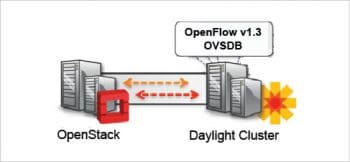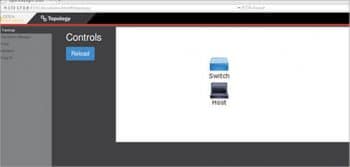The adoption of open source technologies is on the rise, which is evident from the popularity of projects like OpenStack and OpenDaylight. While each project tries to address specific problems, a combination of OpenStack and OpenDaylight projects might be something to look out for.
OpenDaylight started with the release of Hydrogen and is now in its third release cycle, named Lithium. There are more than 60 projects available or being incubated with OpenDaylight Lithium that could satisfy all the networking requirements demanded by SDN. There are also some dedicated projects for OpenStack that are designed and integrated with OpenDaylight.
In this article, I will walk you through the steps in deploying OpenDaylight and integrating it with OpenStack to address use cases specific to networking infrastructure.
1. Assumption
Before getting started, I assume the reader understands OpenStack (kilo) and the set-up is already done.
2. Installing OpenDaylight
OpenDaylight Controller runs in a JVM. So install OpenJDK7 using the command below:
$ apt-get install openjdk-7-jdk
Download the latest OpenDaylight-Lithium package from the official repo, as follows:
$ wget https://nexus.opendaylight.org/content/groups/public/org/opendaylight/ integration/distribution-karaf/0.3.3-Lithium-SR3/distribution-karaf-0.3.3-Lithium-SR3.tar.gz
Uncompress it as the root user, and start OpenDaylight using the following command:
$ tar xvfz distribution-karaf-0.3.3-Lithium-SR3.tar.gz $ cd distribution-karaf-0.3.3-Lithium-SR3/ $ ./bin/start # Start OpenDaylight as a server process and Wait for some time before running the next command below.
Connect to the Karaf shell, as follows:
$ ./bin/client # connecting to the OpenDaylight with the client
Now, you should be in OpenDaylights console. Install all the required features:
opendaylight-user@root> feature:install odl-base-all odl-aaa-authn odl-restconf odl-nsf-all odl-adsal-northbound odl-mdsal-apidocs odl-ovsdb-openstack odl-ovsdb-northbound odldlux-core #Feature installation may take some time to install.
Once the installation is complete, you can check whether everything is working fine by using the curl call shown below:
$ curl -u admin:admin http://<OPENDAYLIGHT SERVERs IP>:8080/controller/nb/v2/neutron/networks
The response should be an empty network list if OpenDaylight is working properly.
Also, you should be able to log in to the dlux interface on http://<OPENDAYLIGHT SERVERs IP>:8181/index.html – the default username and password is admin/admin (see Figure 2).
Additionally, you can find the log details at the location below:
$ tail -f data/log/karaf.log $ tail -f logs/web_access_log_2015-12.txt
Now, you have a working OpenDaylight-Lithium set-up; so, lets get into the integration part.

3. Erase all VMs, networks, routers and ports in the controller node
Since you already have a working OpenStack set-up, you may test for VM provisioning, but before integrating OpenStack with OpenDaylight, you must clean up all the unwanted data from the OpenStack database. When using OpenDaylight as the Neutron back-end, ODL expects to be the only source for Open vSwitch configuration. Because of this, it is necessary to remove existing OpenStack and Open vSwitch (OVS) configurations to give OpenDaylight a clear field.
The following steps will guide you through the cleaning process:
Delete the instances $ nova list $ nova delete <instance names> Remove links from subnets to routers $ neutron subnet-list $ neutron router-list $ neutron router-port-list <router name> $ neutron router-interface-delete <router name> <subnet ID or name> Delete subnets, nets, routers $ neutron subnet-delete <subnet name> $ neutron net-list $ neutron net-delete <net name> $ neutron router-delete <router name> Check that all ports have been cleared - at this point, this should be an empty list $ neutron port-list
While Neutron is managing the OVS instances on compute and control nodes, OpenDaylight and Neutron can be in conflict. To prevent issues, turn off the Neutron server on the network controller and Neutrons Open vSwitch agents on all hosts.
$ service neutron-server stop
4. Configuring Open vSwitches in network and compute nodes
The Neutron plugin in every node must be removed because only OpenDaylight will be controlling the Open vSwitches. So on each host, we will clear the pre-existing Open vSwitch configuration and set OpenDaylight to manage the Open vSwitch.
$ apt-get purge neutron-plugin-openvswitch-agent $ service openvswitch-switch stop $ rm -rf /var/log/openvswitch/* $ rm -rf /etc/openvswitch/conf.db #Clear openvswitch database and start it again. $ service openvswitch-switch start $ ovs-vsctl show #This command must return the empty set except OpenVswitch ID and its Version.
5. Connecting Open vSwitch with OpenDaylight
Use the following commands to make OpenDaylight manage Open vSwitch:
$ ovs-vsctl set Open_vSwitch <OPENVSWITCH ID> other_config={local_ip=<TUNNEL INTERFACE IP>}
$ ovs-vsctl set-manager tcp:<OPENDAYLIGHT MANAGEMENT IP>:6640
You can get the Open vSwitch ID from the command ovs-vsctl show and the tunnel IP from the OpenStack ml2_conf.ini file.
Execute the above command in all the nodes (network and compute nodes) that have Open vSwitch installed.
Create the bridge br-ex, which is needed for the external network for OpenStack in the network (Neutron) node.
$ ovs-vsctl add-br br-ex $ ovs-vsctl add-port br-ex <INTERFACE NAME OF EXTERNAL NETWORK> #commonly eth0 or p2p1 $ ovs-vsctl show
The above command will show that you are connected to the OpenDaylight server, and OpenDaylight will automatically create a br-int bridge.
[root@vinoth ~]# ovs-vsctl show 9e3b34cb-fefc-4br4-828s-084b3e55rtfd Manager tcp:192.XXX.X.XXX:XXXX Is_connected: true Bridge br-int Controller tcp:192.XXX.X.XXX:XXXX fail_mode: secure Port br-int Interface br-int ovs_version: 2.1.3

6. Configuring ml2_conf.ini for the OpenDaylight driver
Edit vi /etc/neutron/plugins/ml2/ml2_conf.ini in all the required nodes and modify the following configuration. Leave the other configurations as they are.
[ml2] type_drivers = flat,vxlan tenant_network_types = vxlan mechanism_drivers = opendaylight [ml2_odl] password = admin username = admin url = http://<OPENDAYLIGHT SERVERs IP>:8080/controller/nb/v2/neutron
7. Configuring the Neutron database
Reset the Neutron database, as follows:
$ mysql -uroot p $ drop database neutron; $ create database neutron; $ grant all privileges on neutron.* to neutron@localhost identified by <YOUR NEUTRON PASSWORD>; $ grant all privileges on neutron.* to neutron@% identified by <YOUR NEUTRON PASSWORD>; $ exit $ su -s /bin/sh -c neutron-db-manage --config-file /etc/neutron/neutron.conf --config-file etc/neutron/plugins/ml2/ml2_conf.ini upgrade head neutron
Restart the Neutron server, using the following command:
$ service neutron-server start
8. Installing the networking_odl Python module
Important: At this stage you will get a message stating Neutron service failed to start. Dont worry; its a temporary issue. Since you have enabled OpenDaylight as a mechanism_driver but not yet installed the Python module for it, you need to install the networking_odl Python module, as follows:
$ apt-get install python-pip $ pip install networking_odl
Now, restart the Neutron server and check its status. It should be running without errors.
9. Verifying the integration
We are almost done with integrating OpenStack with OpenDaylight. Now, its time to verify it.
Create initial networks in OpenStack and check whether they are reflected in OpenDaylight.
You could create the network using the OpenStack horizon dashboard also. Shown below are the commands to create the same in CLI:
$ neutron router-create router1 $ neutron net-create private $ neutron subnet-create private --name=private_subnet 172.0.0.0/24 $ neutron router-interface-add router1 private_subnet $ nova boot --flavor <flavor> --image <image id> --nic net-id=<network id> vinoth-vm1
Once the network creation is done, you will be able to see that the same network has been created in OpenDaylight by using the following command:
$ curl -u admin:admin http://${OPENDAYLIGHTs SERVER}:8080/controller/nb/v2/neutron/networks
The above command will return the network information which is created in OpenDaylight through OpenStack. If the integration has been done correctly, you should now be able to ping VM.
References
[1] http://www.hellovinoth.com/
[2] http://www.cloudenablers.com/blog/
[3] https://www.opendaylight.org/
[4] http://docs.openstack.org/














































































